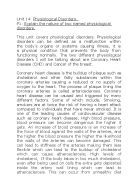Heart failure is a condition in which your heart can't pump enough blood to meet your body’s needs. Heart failure doesn't mean that your heart has stopped or is about to stop working. The most common signs and symptoms of heart failure are shortness of breath or trouble breathing; fatigue; and swelling in the ankles, feet, legs, stomach, and veins in the neck. All of these symptoms are the result of fluid buildup in your body. When symptoms start, you may feel tired and short of breath after routine physical effort, like climbing stairs.
Individuals may also suffer from other symptoms which can include palpitations and unusual breathlessness when exercising or when at rest. Palpitations; when you are aware of your heartbeat being unusually rapid and forceful heartbeat. Fainting - although not always a serious symptom, fainting is due to insufficient oxygen reaching the brain. Fatigue is a common symptom of heart disease, but has numerous causes, including depression. It's always worth seeing your doctor if you feel unusually tired, especially if this is combined with symptoms that can’t be explained. (Class notes. 01 Oct 2012)
Breast cancer rarely has signs or symptoms in it’s early stages, however when a tumor begins to form the cancer of the breast has many symptoms these can include physical changes that can be noticed in the breast. This can include looking out for changes in the breast such as lumps or thickening of the tissue, any flaking skin or discharge from the nipple, 'tethering' of the skin, as if it's being pulled from the inside, any unusual sensation or discomfort, a change in outline, shape or size of the breast, a lump or swelling in either of your armpits, dimpling on the skin of your breasts, a rash on or around your nipple.
( 01 Oct 2012)
M1
There are many Possible difficulties that can be involved in the diagnosis of Coronary heart disease, I will be talking about these below.
Even though an ECG is an important test for detecting heart problems, it isn’t advisable to have an ECG done every year. There are two reasons for this. The first is that there isn’t yet evidence that routine screening actually improves long-term health outcomes. Second, ECGs provide too many false-positive tests, especially in women, leading to unnecessary additional tests and too many false-negative tests which lead to missed abnormalities. However, this advice could change in the future depending on new evidence from the clinical trials.
People who are older or out of shape, have arthritis, lung disease, vascular disease or other medical conditions or those who cannot exercise enough to undergo the exercise tolerance test take a pharmacologic stress test. In place of exercise patients are given medications that increase the heart’s need for blood, allowing doctors to detect blockages that obstruct the supply of blood. A pharmacologic stress test however is not for people who have asthma, emphysema, uncontrolled hypertension, abnormal heart symptoms, carotid artery disease or aortic stenosis. However, the test is considered safe for most people.
Problems that can be involved in the diagnosis of breast cancer can include many women finding having a mammography to be uncomfortable or even painful, but this is normally just for a short time. However, some women may find that the pain or soreness lasts for a few days. Mammograms can sometimes show an abnormal area in the breast that is later found not to be a cancer when further tests are carried out. This is known as a false-positive result. Waiting to get results of further tests can be a very worrying time, and some women may continue to feel anxious even after they’ve been told they don’t have breast cancer (a negative result). About 1 in 20 women who have breast screening will have an abnormal result and be asked to go for further tests. The tests may include more mammograms, ultrasound scans or biopsies of the breast tissue, which can cause pain or scarring. Most of the women asked back for further tests won’t have breast cancer.
One or two mammograms to be taken again for various reasons including the following; The x-ray picture is blurred and cannot be read by the doctor; There is some kind of equipment failure, for example the machine that processes the x-ray films breaks down however this is very rare; The mammogram misses part of the breast and it needs to be retaken so that the whole breast can be seen. Although mammography is the most effective and reliable way of detecting breast cancer early, it is not perfect. A breast cancer may not be detected by mammogram because some cancers are very difficult to see on the x-ray, some cancers, even though they are there, cannot be seen on the x-ray at all, the person reading the x-ray may miss the cancer. This will happen occasionally, no matter how experienced the person reading the x-ray is. To reduce the risk of a cancer being missed all mammograms are looked at by two people.
( accessed 01 Oct 2012)









